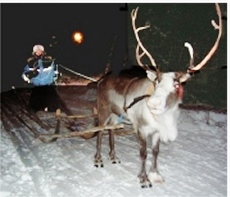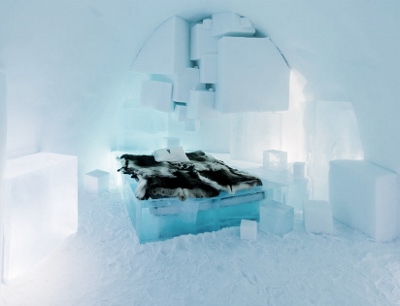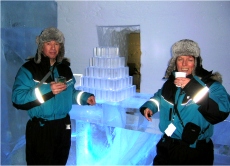Vodka and reindeer meat – my icy adventure
ABOVE the Arctic Circle in Northern Sweden a new building that will stand for just a few short months and then slowly melt into the river, is re-born every year.
The Ice Hotel at Jukkusjarvi, near Karuna, is both a work of art and a stunning wonder of architectural imagination, built completely of ice, in which I was fortunate enough to spend one, incredible night recently.
This crystal wonder is not just a novelty for the adventure-seeking ‘yuppy’, though there were quite a few of them, but a place that inspires a spiritual awareness of the transience of things, both material (it’s easy for the Krona in your wallet to flow away in the Extreme Ice Bar on warming vodka-based cocktails) and of nature itself.
For the harvesting of ice from the Tôrn river every autumn by an ever-changing group of artists, and the slow dissolving of the building fashioned from it by the following Spring, is synonymous with the circular nature of life that is the main tenet of the lives of the Sámi, the indigenous people of the region, struggling to preserve their ancient way of life and culture, based around reindeer herding.
But all this spiritual stuff crept surreptitiously up on me like the wolverine that preys on reindeer calves during the arctic Spring; it was the adventure and the desire for a physical challenge and a tick in the box of ‘things to do before you get too old’ that was my personal motivation originally. And an unusual way to celebrate the 25 years of a marriage.
From Stockhölm, the flight into the twinkling darkness of Karuna (at this time of the year Lapland experiences less than an hour of full daylight) is about 1 hr 40 mins. A 20 minute bus ride, or an optional dog-sled ride carries you to the village of Jukkusjarvi and the Ice Hotel complex itself. This includes a fantastically domed and eerily-silent ice chapel, a conventional wooden reception building, log cabins and locker room where you are kitted out with insulated snow suit, warm boots, extra thick gloves and fur-edged windproof hat ¬- indispensable in the averagely minus 13 degrees Centigrade outside temperature, and minus three or four inside the Ice Hotel itself.
The snowmobile has been the favoured mode of transport for the local people since the 1950’s, enabling them to go where no reindeer or dog team could venture, and the modern, four-stroke vehicle is easy to drive and manoeuvre and great fun, especially through the snow-topped trees that lead to the Sámi encampment where we were served freshly cooked reindeer meat (a succulent cross between beef and lamb) and vegetable soup, Lingenberry juice and the best coffee I’ve tasted for a long time.
No less exhilarating was the dog-sled ride the next day across the frozen Torn river, lead by a local character in reindeer fur coat and skin trousers with tassels blowing in the wind. What is striking about this mode of transport is the absence of sound – only the occasional whistle of a bird, no aeroplanes, no traffic and no howling wind; just the swish of sled runners over the snow and the occasional low-key whistles and words of encouragement and instruction from the driver to his pack. This lack of ambient noise, coupled with the constant twilight and the day-long presence of the moon, creates a dream-like and strangely calming atmosphere after the earlier, manic barking and excitement of the dogs, straining and howling and leaping about excitedly wanting to get going.
During a visit to a Reindeer enclosure in the forest, where the animals are brought together for the winder, we were taken into a Sámi Kåta, a type of teepee, where Johanne, our Sámi guide lit a huge log fire in the middle upon which he cooked us fresh reindeer meat just as his ancestors have done since the retreat of the ice-age, 10,000 years before. As we sat around in the dark on brushwood covered with reindeer skins, we watched the smoke drift upwards out of the hole at the top of the tent and listened to Johanne describing his people’s history, their annual struggle of rounding up their reindeer to bring them down from the mountains for the winter, how different nations have slowly taken away their autonomy over what they see as their land and water, have taxed them by taking meat, fish and skins and how these days, their livelihood is being threatened by cheap reindeer meat being bought in from Russia.
 Johanne had previously demonstrated the art of driving a reindeer sledge and we were all given the opportunity the have a go. Unfortunately, these stubborn beasts only seemed to respond to the voices of their keepers and my animal particularly, after an initial dash from the starting point, ground to halt and proceeded to scrape in the snow with his hoof for moss and to eat snow. As three other sledges backed up behind me, no amount of yelling, cursing or thwacking it on the backside with the rein, could induce this animal to proceed any faster than an intermittent stop-start to the finishing point.
Johanne had previously demonstrated the art of driving a reindeer sledge and we were all given the opportunity the have a go. Unfortunately, these stubborn beasts only seemed to respond to the voices of their keepers and my animal particularly, after an initial dash from the starting point, ground to halt and proceeded to scrape in the snow with his hoof for moss and to eat snow. As three other sledges backed up behind me, no amount of yelling, cursing or thwacking it on the backside with the rein, could induce this animal to proceed any faster than an intermittent stop-start to the finishing point.
After an afternoon of physical activity out in the fresh air, the actual stay in the Ice Hotel loomed nearer and the whole group began to conjecture about the night ahead. Would it really be possible to sleep on a block of ice? What should one wear inside the sleeping bag? Thermal underwear and warm socks were a must – so we’d heard. What do you do if you need a pee in the middle of night? Would the sound of snoring carry into the neighbouring rooms? Soon we would find out.
The general consensus among old-hands at this was that you visit the Extreme Ice Bar and consume several vodkas before returning to the locker room where you change into your night clothes, clean your teeth and any other bits of you that, by this point of exhaustion and alcohol-induced state of relaxation, you can be bothered to wash, struggle back into your snow suit and boots and head off for your room along an icy corridor. Once there, we followed the instructions of the friendly tour guide and quickly removed our snow suit, laying it carefully out on the bed, climbed into the extra thick sleeping bag provided and then lay down on top of the suit, plus a 10 cm layer of foam rubber and several reindeer skins that gave off a vaguely musky smell. The only bit of the body left exposed is one’s head; it is advisable to wear a warm hat and to zip the sleeping bag all the way up, all around the head so that the only bit visible is your face.
At last I was as ‘snug as a bug’ and in the absolute silence, very quickly fell asleep. Sometime later, I awoke. My feet were roasting, my head felt like it was on fire and I was under the impression that I was sitting in a dark cave, looking out through a small hole on to an icy, Narnia-like landscape. Either it was the vodka or a very high temperature was causing me to hallucinate. I removed the hat, unzipped the sleeping bag from around my face and immediately began to cool down and realise where I was. Husband John snored gently on beside me. Apart from a short spell when I awoke again to put my hat back on because my ears were cold and to take a few mouthfuls of water from a plastic bottle I’d stood beside the bed, I slept deeply until awakened by a friendly face in a brown furry hat, coming through the blanket-curtained opening proffering a cup of hot lingenberry juice. (Mysteriously, despite the ambient temperature being well below freezing, my water did not freeze – answers on a postcard please to…editor@thamenews.net) Then it was a question of retrieving the warm snow suit from underneath yourself, putting it on as quickly as possible while you were still glowing from the hot drink, stepping into the cold boots beside the bed and then dashing off for a sauna, a shower and then breakfast – all a few hundred metres away from the Ice Hotel itself. (Husband John, egged on by an alpha male, virile young Scotsman sharing our sauna cabin, did the Swedish thing of dashing out of the sauna and rolling in the show before running back in – luckily it was very early in the morning and dark!)
After a second night spent in the more familiar surroundings of a warm, wooden cabin, came the day of our return to London, via a connecting flight from Stockholm. From my seat by the window, I reassuringly watched a man spray anti-freeze on the aircraft’s wings before we took off from the tiny airport at Karuna and headed back to the damp, grey skies of England.
Other memorable moments:- drinking Glŏgg, a sort of mulled wine sweetened with raisins and almonds and warming our hands by a brazier of burning logs at the Christmas market in Stockholm; watching children looking at animated scenes from fairy stories in a Stockholm department store’s windows; eating a wonderful dessert made from baked slices of pineapple in a lemony, vanilla sauce; the friendly Swedish people always ready to chat; seeing a set of reindeer horns, the points carefully wrapped in brown paper and sellotape going past on the baggage conveyor belt at the airport; noticing the difference between three polite and well-behaved Swedish children entertaining themselves quietly on the plane whilst one ill-disciplined noisy English child annoyed everyone within ear-shot for most of the journey; the pride in his people that Johanne’s demeanour and voice expressed despite their plight and above all, a feeling of outrage that colonisers can be so thoughtless and uncaring about what they do to an indigenous people when they rush in to take what they want.
Aim for the new year – to spread the word about Swedish reindeer meat; its cholesterol-free, very lean and succulent, and delicious. So, if you are, or know a restaurateur, find out where in Sweden you can buy in some reindeer meat and let’s make it the healthy alternative and most fashionable item on the menu, and help the heroic and beautiful Sámi people to survive.
http://www.keziefoods.co.uk/Catalogue/Exotic-Meats/Reindeer-Meat
For more information about the Sámi people, visit: https://sweden.se/society/sami-in-sweden/
For more information about the ice hotel in Sweden, visit: http://www.icehotel.com/



